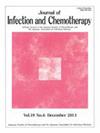棒状杆菌引起肉芽肿性乳腺炎的临床和微生物学特征:一个病例系列。
IF 1.9
4区 医学
Q3 INFECTIOUS DISEASES
引用次数: 0
摘要
棒状杆菌是肉芽肿性乳腺炎(GM)的重要病因。虽然世界范围内已经有由克氏棒状杆菌引起的感染的报道,但很少有关于硬脂棒状杆菌GM的病例报道。我们对2014年1月1日至2024年5月31日期间由棒状杆菌引起的转基因临床和微生物学特征进行了回顾性研究。研究期间共发现6例GM患者,其中4例为克氏梭菌GM, 2例为硬脂结核梭菌GM。患者均为女性,年龄18-50岁,中位年龄32岁。所有患者均行手术引流,并用克拉霉素治疗。硬脂结核杆菌对阿奇霉素、克拉霉素、环丙沙星、克林霉素和甲氧苄啶磺胺甲恶唑等多种抗菌剂的最低抑菌浓度(MIC)均高于克氏结核杆菌。此外,MALDI-TOF MS和16s rRNA基因测序准确地鉴定了C. kroppenstedtii和C.结核菌硬脂质。亲脂棒状杆菌的准确鉴定对抗菌药物的选择具有重要意义。如果临床医生怀疑嗜脂棒状杆菌感染,特别是转基因,他们应该要求微生物实验室检测嗜脂棒状杆菌。本文章由计算机程序翻译,如有差异,请以英文原文为准。
Clinical and microbiological characteristics of granulomatous mastitis caused by Corynebacterium species: A case series
Corynebacterium species are an important cause of granulomatous mastitis (GM). Although there have been worldwide reports of infections caused by Corynebacterium kroppenstedtii, few cases of C. tuberculostearicum GM have been reported. We conducted a retrospective study to investigate the clinical and microbiological characteristics of GM caused by Corynebacterium spp. between January 1, 2014, and May 31, 2024. During the study period, six patients with GM were identified, including four cases of C. kroppenstedtii GM and two cases of C. tuberculostearicum GM. All patients were female with a median age of 32 years (range: 18–50 years). All patients underwent surgical drainage and were treated with clarithromycin. The minimum inhibitory concentration (MIC) values for various antimicrobial agents, including azithromycin, clarithromycin, ciprofloxacin, clindamycin, and trimethoprim-sulfamethoxazole, were higher for C. tuberculostearicum than for C. kroppenstedtii. Additionally, MALDI-TOF MS and 16s rRNA gene sequencing accurately identified C. kroppenstedtii and C. tuberculostearicum. Accurate identification of lipophilic Corynebacterium spp. is important for antibiotic treatment selection. If clinicians suspect lipophilic Corynebacterium spp. infection, particularly GM, they should ask the microbiology laboratory to test for lipophilic Corynebacterium spp.
求助全文
通过发布文献求助,成功后即可免费获取论文全文。
去求助
来源期刊

Journal of Infection and Chemotherapy
INFECTIOUS DISEASES-PHARMACOLOGY & PHARMACY
CiteScore
4.10
自引率
4.50%
发文量
303
审稿时长
47 days
期刊介绍:
The Journal of Infection and Chemotherapy (JIC) — official journal of the Japanese Society of Chemotherapy and The Japanese Association for Infectious Diseases — welcomes original papers, laboratory or clinical, as well as case reports, notes, committee reports, surveillance and guidelines from all parts of the world on all aspects of chemotherapy, covering the pathogenesis, diagnosis, treatment, and control of infection, including treatment with anticancer drugs. Experimental studies on animal models and pharmacokinetics, and reports on epidemiology and clinical trials are particularly welcome.
 求助内容:
求助内容: 应助结果提醒方式:
应助结果提醒方式:


